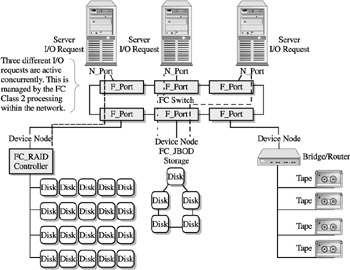Fabric Operation from a Hardware Perspective
| |
The SANs fabric operates through, and is governed by, the logical components of the Fibre Channel standard previously mentioned. The standard is broken down into logical constructs of frame, sequence, and exchanges. FC provides its storage flexibility through the ability to transport other protocols, such as the SCSI protocol.
-
Frame The logical construct of transporting data through the switch.
-
Sequence A block of numbered or related frames transported in sequence from initiator to target. Error recovery takes place as the receiving port processes the sequence.
-
Exchange A number of nonconcurrent sequences processed bidirectionally (it should be noted, however, that a port can only process one sequence at a time). Although a single port is limited to single sequence processing, it can process multiple simultaneous exchanges.
Within the overall FC protocol standard are embedded the primitive sequence protocols used for error recovery during exchange processing. Fabric login is used to communicate the ports operation characteristics. Operations are directed by the N_Port login and logout commands, which provide session-level parameters as ports issue and exchange sequences. The exchanges are made up of frames (as shown in Figure 14-9) and indicate the large user data area or payload that allow FC protocols to transmit at gigabit speeds.

Figure 14-9: Anatomy of the FC Frame
Selected by the port at login, the class of service and other parameters the switch will support directs flow control of the frames. Flow control is determined by connection attributes between communicating devices. This process is similar to network operations where connections are either mindful of their state and acknowledge transmission and receipt, or disregard their state, acknowledgment, and effective frame recovery. Although there are six classes of operation defined by the FC standard, only three are useful to data storage operations, and therefore worthy of mention.
-
Class 1 A dedicated connection in which two devices establish complete control and dedicated bandwidth of the link. Until they complete their transactions, the ports remain busy and unavailable to any other traffic. Although useful for batch type operations and data streaming when the complete bandwidth of the link can or must be used, Class 1 operation performs best in transactional- intensive workloads like OLTP, web, or data warehousing.
-
Class 2 A switched bandwidth sharing connection ( considered connectionless) providing a form of time-slicing algorithms that share bandwidth, thus enabling multiple exchange activities to take place. Although Class 2 service does have acknowledgment of frame delivery, frames do not have ordered, guaranteed delivery, and thus must wait their turn in the linking schedule to perform the reordering of frames within the routing mechanism set up by the vendor. Class 2 ( illustrated in Figure 14-10) demonstrates its value in typical application I/O workload situations. It can handle the transaction rates an OLTP or time- dependent system might throw its way.

Figure 14-10: Typical flow control using Class 2 operation -
Class 3 A connectionless buffer-to-buffer flow mechanism that offers a quick way to broadcast messages within a multicast group . However, cutting out the recipient acknowledgment and buffer coherence means introducing a high risk of frame loss. Class 3 works well for specialized applications that broadcast requests to devices. Without the retransmission of the request in other class processing, this limits the useful value to simple data replication and browsing/ searching acknowledgment.
| |
EAN: 2147483647
Pages: 192